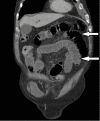Intussusception in Incisional Hernia: A Case Report and Literature Review
- PMID: 38143605
- PMCID: PMC10748933
- DOI: 10.7759/cureus.49346
Intussusception in Incisional Hernia: A Case Report and Literature Review
Abstract
Intussusception in adults is a rare condition. Most frequently, intussusception involves the small intestine and, very rarely, the large intestine. In this report, we present the case of a 79-year-old male who was admitted with symptoms and signs of bowel obstruction due to an incarcerated incisional hernia (a tender irreducible incisional hernia associated with nausea and vomiting). His CT scan confirmed intussusception in his incisional hernia, showing the target sign. An emergency laparotomy, small bowel resection, and anastomosis were done. The histopathology report revealed the cause of intussusception to be a polypoid small bowel B cell lymphoma. It is necessary to excise the affected bowel segment in order to treat adult intussusception because it is commonly associated with malignant organic lesions. Computed tomography is the most sensitive imaging modality for intussusception; thus, we must consider a low threshold for a scan for patients presenting with abdominal pain.
Keywords: bowel obstruction; incarcerated incisional hernia; incisional hernia; intussusception; surgical management of intussusception.
Copyright © 2023, Hassan et al.
Conflict of interest statement
The authors have declared that no competing interests exist.
Figures




Similar articles
-
Adult intussusception: A case report.Int J Surg Case Rep. 2023 Apr;105:107977. doi: 10.1016/j.ijscr.2023.107977. Epub 2023 Mar 16. Int J Surg Case Rep. 2023. PMID: 36989624 Free PMC article.
-
Diffuse large B-cell lymphoma associated ileocecal intussusception in adulthood.Klin Onkol. 2022 Spring;35(3):236-239. doi: 10.48095/ccko2022236. Klin Onkol. 2022. PMID: 35760577 English.
-
An unusual form of incisional hernia: A case report of Littre's hernia.Int J Surg Case Rep. 2023 Dec;113:109066. doi: 10.1016/j.ijscr.2023.109066. Epub 2023 Nov 16. Int J Surg Case Rep. 2023. PMID: 37979554 Free PMC article.
-
Small bowel intussusception from renal cell carcinoma metastasis: a case report and review of the literature.J Med Case Rep. 2016 Aug 11;10(1):222. doi: 10.1186/s13256-016-0998-0. J Med Case Rep. 2016. PMID: 27509833 Free PMC article. Review.
-
Recurrent intussusception as initial manifestation of primary intestinal melanoma: Case report and literature review.World J Gastroenterol. 2015 Mar 14;21(10):3114-20. doi: 10.3748/wjg.v21.i10.3114. World J Gastroenterol. 2015. PMID: 25780313 Free PMC article. Review.
References
Publication types
LinkOut - more resources
Full Text Sources
